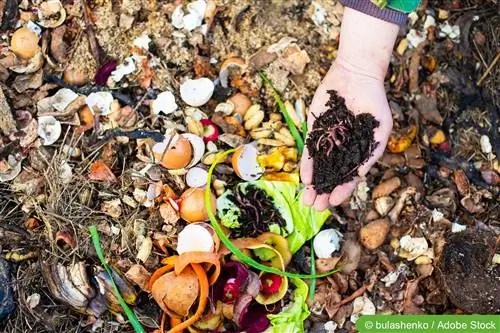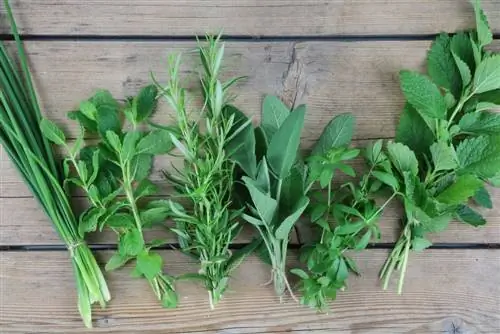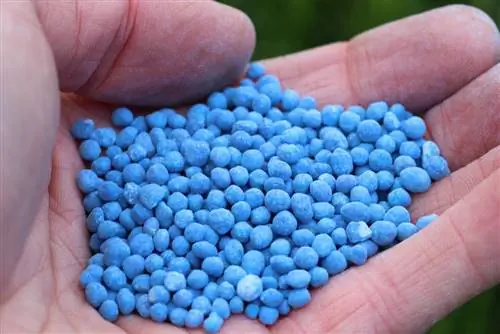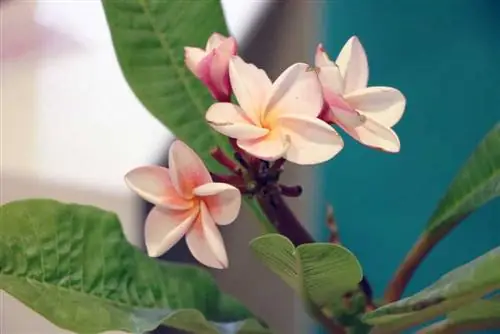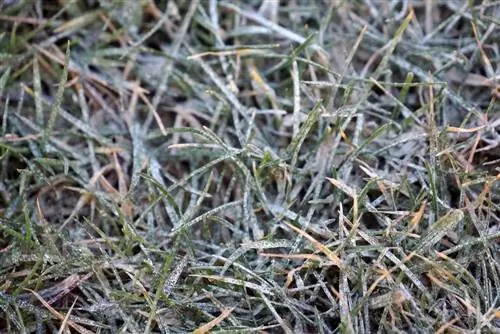- Author admin [email protected].
- Public 2023-12-17 03:39.
- Last modified 2025-06-01 06:48.
If you want your garden to bloom and thrive, you will not be able to avoid adding additional nutrients in the form of fertilizer. The hobby gardener's first trip is usually to the nearest hardware store or gardening department, where fertilizer is available in many different varieties. But there is a lot to be said for avoiding mineral fertilizers and using natural alternatives. This is not only advantageous from an ecological point of view, but also from a financial point of view.
Mineral s alts in chemical or natural form
No matter what form they are presented in, nutritional s alts are exactly the same in form. This speaks for the advocates of chemical fertilizers. However, one criticism is that a lot of energy is used in the production of this fertilizer and thus pollutes the environment. The more chemical fertilizer is used, the faster there is a risk of over-fertilizing the soil, which over time can lead to the extinction of plant species that do not actually need nutrient-rich soil. Young plants in particular are easily over-fertilized because the mineral s alts are immediately absorbed by the plants. Natural fertilizer cannot be fed into the cycle immediately, but must first be slowly broken down by insects so that the nutrients can be released.
Fertilizers proven for centuries
For every plant, whether in the garden or for potted plants, there are fertilizers that can easily be obtained from leftover food, for example. There are some things that you wouldn't think of at first that could improve the nutrient content in the soil.
Banana - the vitamin tablet for flowering plants
Banana peels are a real vitamin boost not only for flowering plants on the windowsill, but also for all plants in the garden such as roses. However, it should be an organic product so that no toxins get into the soil. The shells are cut into small pieces and placed just below the surface of the soil.
No old coffee
Potassium, nitrogen and phosphorus are three substances that plants are very grateful for. These are present in sufficient quantities in the coffee grounds. The lawn becomes wonderfully strong and green with the addition of coffee grounds, as it promotes root growth, metabolism and flower growth in flowering plants such as rhododendrons or geraniums. The coffee grounds attract beneficial insects, whose excretions in turn act as fertilizer.
Don't throw anything away
You can also conjure up a splendor of flowers in summer by using boiled potato water or vegetable stock as irrigation water, but this must not contain any s alt. A cube of yeast dissolved in 20 liters of water has a similar effect. These two methods can be varied by leaving eggshells in water overnight.
Tip:
Plants love mineral water. So before you throw away stale water, you should give it to your plants.
Back to nature
Other leftovers from everyday use that can be further used are, for example, ash, which must not be made of pressboard or contain residues of glue or paint or black tea.
Let vegetables thrive. Two alternatives are recommended, especially for vegetables. If you want to promote the growth of tomatoes, for example, but also fight fungal infestation at the same time, you can use skimmed milk. If you mix it 1:8 with water, it is ideal as a fertilizer. With the help of a spray bottle, skimmed milk can be easily distributed on the plants and thus provides reliable protection against fungi. A decoction made from onion peels has a similar effect and is also sprayed onto the plants.
Green manure is worth it
The method that improves the quality of the soil originally comes from agriculture. By growing certain green plants, temperature fluctuations on the ground can be well balanced. In addition, the Biden is less likely to become muddy and crusty. At the same time, the quality of the soil organisms is improved, which in turn promotes the growth of other plants. Lupins or sunflowers are deep-rooted plants that can even counteract growth underground. Other plants that are suitable for green manure include mustard, oats, oil radish, buckwheat or marigolds. The disadvantage here is certainly the high level of effort that has to be put in to create the foundation. On the other hand, cultivation is worthwhile, especially in the long term. These plants can also be used well, such as marigold for making ointments. Green manure also promotes the formation of humus.
Humus and manure
Of course you can also make hummus yourself. Both garden and kitchen waste are ideal for this. It is best to place the compost heap in a location that is not too sunny, so you can prevent the compost from drying out too quickly or becoming too moist too quickly and then molding. In order for the waste to decompose, beneficial organisms such as earthworms must get into the compost. Therefore, the subsurface should not be sealed, but should be on natural soil. A wire mesh made of fine-meshed net can certainly be placed underneath, for example to keep voles away. The hummus is best when the ingredients are mixed well, which means that the ingredients should consist of both fine and coarse material. The compost must be mixed well at regular intervals. Manure, which is ultimately an animal waste product, can also be used for natural garden fertilization, even if the odor nuisance is not for everyone.
Frequently asked questions
Can I use natural and chemical fertilizers together?
Usually yes. However, you should make sure that the soil is not over-fertilized. Chemical fertilizers are absorbed by the plants immediately, natural fertilizers take a little longer.
Can I also buy fertilizers of course?
Natural ready-made fertilizers are now available to buy more and more often, although the tips mentioned above are much more cost-effective.
Can I harm my plants by not using chemicals?
Under no circumstances, because over-fertilization is basically impossible.
Conclusion: chemical vs. natural garden fertilizers
If you want fruit, vegetables and salad to thrive, you usually use garden fertilizer. This is available ready-made in various packaging contents in hardware stores and garden centers. When it comes to garden fertilizer, the question is, of course, how flexible it can be used, i.e. whether it is suitable for fertilizing several types of plants. The answer comes from the ingredients. Recent tests have shown that many products contain immense amounts of uranium, which comes from the phosphate used, although uranium is still not regulated as a component of garden fertilizers. In addition, in Germany there are also very moderate limit values for heavy metals in garden fertilizers, although heavy metals could enter the food chain via plants or groundwater.
There are other loopholes for fertilizer manufacturers. You can declare your garden fertilizers as EU fertilizers, although limit values only apply to mineral fertilizers at EU level. As a rule, these are heavy metals such as arsenic and cadmium, but also chromium, copper and zinc. These heavy metals in particular can accumulate in the human body and damage organs. But there are alternatives. In addition to fertilizers containing uranium, fertilizers rich in phosphates can also cause problems with fertilization, including the so-called blue grain.
Organic fertilizers contain a lot of additional trace elements. In addition, they are free of animal ingredients. Organic fertilizers, such as compost, horn or bone meal, on the other hand, usually have lower uranium contents, although with compost two to three liters per square meter per year are usually sufficient, otherwise the soil is quickly over-fertilized. The best option is a fertilizer that has a targeted addition of nutrients that the soil actually needs. To check whether it is necessary, you should order a soil test every three to five years.

